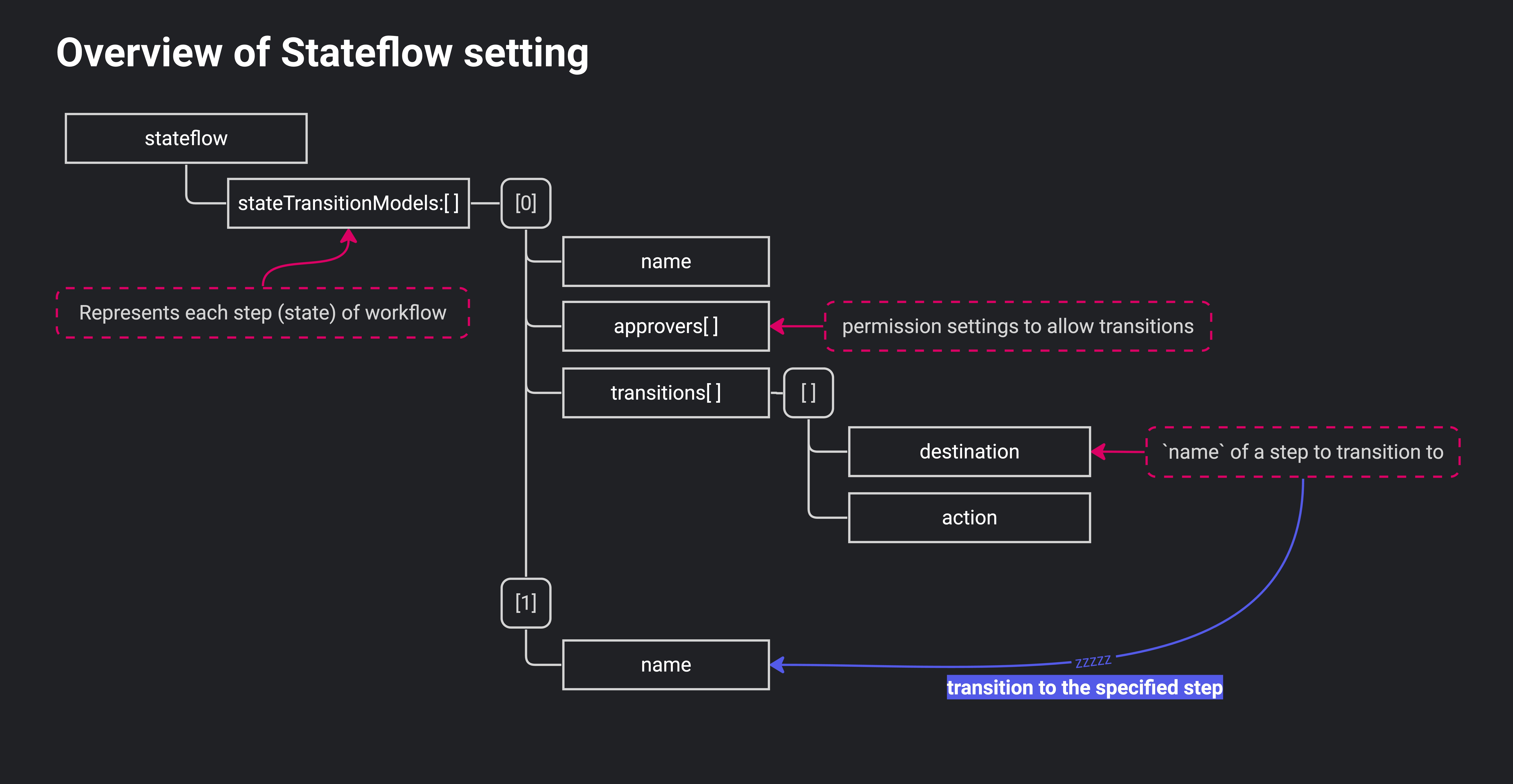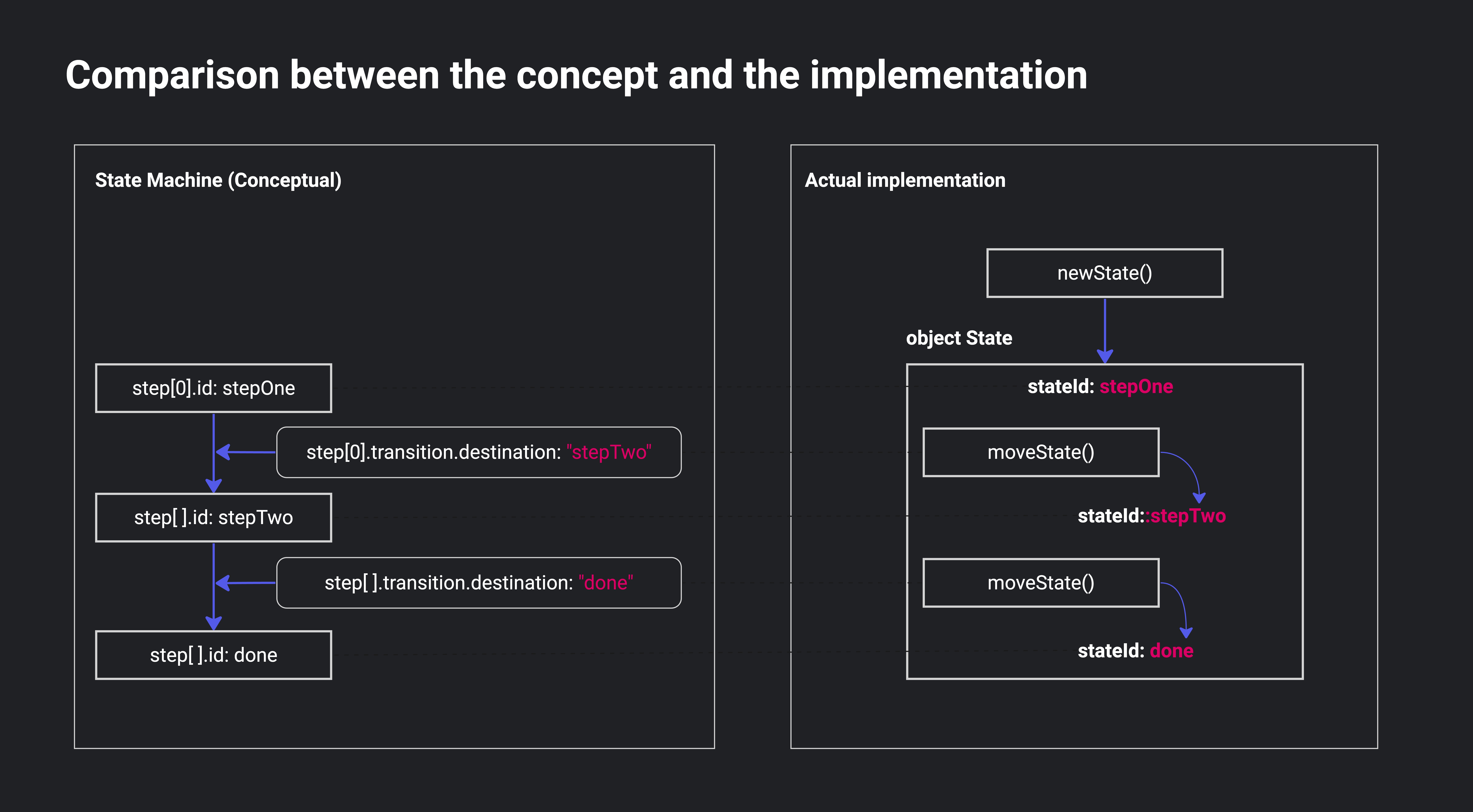StateFlow service
Deprecated Service
This service is deprecated and will be removed in a future release. Use built-in permissions, or for historical capture, use CDC with a TailorDB table.
Learn the key concepts and usage of the StateFlow service.
Introduction
A StateFlow is a sequence of steps that transforms static data into dynamic processes aimed at driving business outcomes,
such as routing jobs to the appropriate employee or soliciting approvals from managers.
The StateFlow service helps you create your tailored business processes by defining states, approvers and transitions.
Key features
- Defining StateFlow You can define your custom flow for your business processes by defining states containing approvers and transitions.
- Managing StateFlow state with a State You can create a State to manage the state of resource transitions. Only valid approvers can update a State's status so you can manage your process properly.
Key concepts
- StateFlow: The data type allows you to define states to be transitioned, authorized approvers for the steps and actions to be taken at the time of transition.
- State: The data type to manage the state of a resource in your schema. Each State is associated with a specific resource ID in your data and a StateFlow ID you created. Based on the StateFlow, State transitions through the steps of that resource.
- Approvers: The resource IDs such as users and roles who can update the State with actions and transition steps of the StateFlow.
- Transitions: The paths of the StateFlow which contains actions to determine the next destination of the StateFlow. Transitions can have multiple paths. You can specify the next step of the StateFlow by assigning an ID of the step in the StateFlow.
StateFlow overview
The diagram illustrates how a StateFlow is set up. Each component is described below.

Key parameters of StateFlow
StateFlow
Fields
| Name | Data Type | Description |
|---|---|---|
| id | ID! | An identifier of this StateFlow rule. This |
| name | String | The name of the StateFlow |
| stateTransitionModels | [[stateTransitionModel!]] | The list of state transition models |
StateTransitionModel
Fields
| Name | Data Type | Description |
|---|---|---|
| approvers | [[Approver!]] | Permission settings of users who can trigger the transition |
| description | String | The description of State transition model |
| name | String | The name of State transition model |
| transitions | [[Transition!]] | Defines the next steps that can be transitioned from this state |
Approver
Fields
| Name | Data Type | Description |
|---|---|---|
| id | ID! | UUID of a user or a group that can trigger the transition with
|
| condition | String | Condition of approver |
Transition
Fields
| Name | Data Type | Description |
|---|---|---|
| action | String! | Name of the action. This |
| destination | String! | The specifier to which the State transits. This should match one of the |
Configuration of StateFlow
StateFlows are made of a set of steps. When you design your stateflow, steps is the actual object you need to create by defining approvers and transitions as a list.
Here's the sample of steps.
As described in the Key concept, approvers are IDs of your resources to update State. This can be user ID, roles or groups -- whatever the resource ID to update the Ticket. When moveState mutation is performed, StateFlow service will verify the user with the approvers and the transition will be made only when the ID of the user matches to approvers or the user belongs to at least one of the resources specified in approvers.
<span><span style="color: var(--shiki-token-function)">sampleStateFlowSteps</span><span style="color: var(--shiki-color-text)">:</span></span>
<span><span style="color: var(--shiki-color-text)">[</span></span>
<span><span style="color: var(--shiki-color-text)"> {</span></span>
<span><span style="color: var(--shiki-color-text)"> </span><span style="color: var(--shiki-token-string)">id</span><span style="color: var(--shiki-color-text)">: </span><span style="color: var(--shiki-token-comment)">"InitialState"</span><span style="color: var(--shiki-color-text)">,</span></span>
<span><span style="color: var(--shiki-color-text)"> </span><span style="color: var(--shiki-token-string)">name</span><span style="color: var(--shiki-color-text)">: </span><span style="color: var(--shiki-token-comment)">"RequestForApproval"</span><span style="color: var(--shiki-color-text)">,</span></span>
<span><span style="color: var(--shiki-color-text)"> </span><span style="color: var(--shiki-token-string)">approvers</span><span style="color: var(--shiki-color-text)">: [</span></span>
<span><span style="color: var(--shiki-color-text)"> {</span></span>
<span><span style="color: var(--shiki-color-text)"> </span><span style="color: var(--shiki-token-string)">id</span><span style="color: var(--shiki-color-text)">: <userX_UUID></span></span>
<span><span style="color: var(--shiki-color-text)"> }</span></span>
<span><span style="color: var(--shiki-color-text)"> ],</span></span>
<span><span style="color: var(--shiki-color-text)"> </span><span style="color: var(--shiki-token-string)">transitions</span><span style="color: var(--shiki-color-text)">: [</span></span>
<span><span style="color: var(--shiki-color-text)"> {</span></span>
<span><span style="color: var(--shiki-color-text)"> </span><span style="color: var(--shiki-token-string)">action</span><span style="color: var(--shiki-color-text)">: </span><span style="color: var(--shiki-token-comment)">"Approve"</span><span style="color: var(--shiki-color-text)">,</span></span>
<span><span style="color: var(--shiki-color-text)"> </span><span style="color: var(--shiki-token-string)">destination</span><span style="color: var(--shiki-color-text)">: </span><span style="color: var(--shiki-token-comment)">"UserXApprovedState"</span></span>
<span><span style="color: var(--shiki-color-text)"> }</span></span>
<span><span style="color: var(--shiki-color-text)"> ]</span></span>
<span><span style="color: var(--shiki-color-text)"> },</span></span>
<span><span style="color: var(--shiki-color-text)"> {</span></span>
<span><span style="color: var(--shiki-color-text)"> </span><span style="color: var(--shiki-token-string)">id</span><span style="color: var(--shiki-color-text)">: </span><span style="color: var(--shiki-token-comment)">"UserXApprovedState"</span><span style="color: var(--shiki-color-text)">,</span></span>
<span><span style="color: var(--shiki-color-text)"> </span><span style="color: var(--shiki-token-string)">name</span><span style="color: var(--shiki-color-text)">: </span><span style="color: var(--shiki-token-comment)">"UserXApproved"</span><span style="color: var(--shiki-color-text)">,</span></span>
<span><span style="color: var(--shiki-color-text)"> </span><span style="color: var(--shiki-token-string)">approvers</span><span style="color: var(--shiki-color-text)">: [</span></span>
<span><span style="color: var(--shiki-color-text)"> {</span></span>
<span><span style="color: var(--shiki-color-text)"> </span><span style="color: var(--shiki-token-string)">id</span><span style="color: var(--shiki-color-text)">: <userY_UUID></span></span>
<span><span style="color: var(--shiki-color-text)"> }</span></span>
<span><span style="color: var(--shiki-color-text)"> ],</span></span>
<span><span style="color: var(--shiki-color-text)"> </span><span style="color: var(--shiki-token-string)">transitions</span><span style="color: var(--shiki-color-text)">: [</span></span>
<span><span style="color: var(--shiki-color-text)"> {</span></span>
<span><span style="color: var(--shiki-color-text)"> </span><span style="color: var(--shiki-token-string)">action</span><span style="color: var(--shiki-color-text)">: </span><span style="color: var(--shiki-token-comment)">"Approve"</span><span style="color: var(--shiki-color-text)">,</span></span>
<span><span style="color: var(--shiki-color-text)"> </span><span style="color: var(--shiki-token-string)">destination</span><span style="color: var(--shiki-color-text)">: </span><span style="color: var(--shiki-token-comment)">"done"</span></span>
<span><span style="color: var(--shiki-color-text)"> }</span></span>
<span><span style="color: var(--shiki-color-text)"> ]</span></span>
<span><span style="color: var(--shiki-color-text)"> },</span></span>
<span><span style="color: var(--shiki-color-text)"> {</span></span>
<span><span style="color: var(--shiki-color-text)"> </span><span style="color: var(--shiki-token-string)">id</span><span style="color: var(--shiki-color-text)">: </span><span style="color: var(--shiki-token-comment)">"done"</span><span style="color: var(--shiki-color-text)">,</span></span>
<span><span style="color: var(--shiki-color-text)"> </span><span style="color: var(--shiki-token-string)">name</span><span style="color: var(--shiki-color-text)">: </span><span style="color: var(--shiki-token-comment)">"ApprovedByAll"</span></span>
<span><span style="color: var(--shiki-color-text)"> }</span></span>
<span><span style="color: var(--shiki-color-text)">]</span></span>
<span></span>Changing states with State
The diagram below illustrates how a StateFlow transition works using State from an implementation perspective. newState and moveState are both described below.

Key fields of State
State
Fields
| Name | Data Type | Description |
|---|---|---|
| currentState | String | An identifier of the current step of this state. This should match one of the |
| id | ID! | |
| resourceID | String | An identifier of the record that this state is associated to. This should match one of the UUIDs of the record in Tailor DB. |
| stateFlow | StateFlow | An identifier of the stateFlow from which this State is generated |
newState
In Tailor Platform, the state of a particular record in Tailor DB is managed by a State.
You can think of a State as a record of the state of a resource that is managed according to your stateFlow at a particular point in time.
To create a State, you need to execute the newState
mutation with the stateFlow ID, and the resource ID that you want to manage.
When a State is created, both a stateFlow and the resource are tied together,
and the initial step ID in the stateFlow steps will be automatically assigned to the currentState field in the created State.
In the case of the "sampleStateFlowSteps" example provided above, the initial state is InitialState.
moveState
When you want to change the state of the record according to the stateFlow, you need to execute moveState mutation for the State.
As defined in the associated stateFlow, the state can only transition to the steps that is defined in the transitions of your steps. Also, moveState need to be executed by a user defined in approvers in the steps.
This means in the case of sampleStateFlowSteps above, only userX can perform moveState and move the step.
Since the steps dictates the possible transition for each step, the state cannot move from InitialState to done directly.